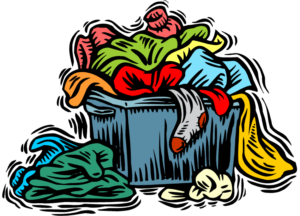Purging is an often recommended and common sense first step to organizing. When we’re dealing with documents, most of us aren’t always sure what to toss, what to keep and for how long. Here are some guidelines to get you started on handling common types of documents. Your situation may be more complex, if, for instance, you have chronic health problems, or have a business. When in doubt, ask an accountant, attorney, daily money manager, or other trusted professional. When it comes to those documents that you should keep, consider that most of the documents can be scanned and the hard copies discarded.
TOSS
KEEP SHORT TERM
KEEP LONG TERM
KEEP PERMANENTLY
Finding the time and energy to garden has been a challenge for me in the past few years. Our property seems to be getting bigger or am I getting older? Regardless of the reason, I’m not willing to give up the great exercise and satisfaction I get from planting my garden, so I need to get more organized to get it done. I also have to be satisfied with an hour or two here and there instead of a full day of gardening. After I planted my garden last year, I took pictures of the planters and the gardens and made a list of the plants I bought at the local nurseries. Next year, it will be much easier to start the process!
Our garden shed was built on top of an old outhouse and frankly it could withstand a hurricane. It has a waist high counter and wooden shelving. We used leftover linoleum flooring from the kitchen for the floor. Mice and other critters frequently visit the shed in the winter, so I need to be mindful of how I store items.
My garden shed is just the right size to hold the following:
In the spring:
In the fall after the first killing frost:
After plants have been hit by frost, I like to fill in with fall décor so it doesn’t look so empty. I use some of the more colorful pots I emptied and place them upside down to hold mums. I fill in with straw bales, pumpkins, cornstalks and gourds. Organize your gardening so it’s a pleasure, not a chore.

5 5 Steps To Organizing Your Family’s Summer Calendar
1. Print a three month calendar for June, July & August. Click this link to see if this one might work for you: http://www.crayonfreckles.com/2017/05/25-summer-activities-and-free-printable.html
2. Add holidays, birthdays, party invitations and vacation days. You can attach any information about these events to the back of the calendar.
3. Add any camps your children are signed up for.
4. Cherish the downtime. The lazy days of summer are important so be sure to cherish the downtime! Leave them blank for spontaneous fun.
5. However, if you feel incline you can create a loose timeline for the downtime. For instance:
▪ 9:00am wake- eat breakfast, wash-up, make your bed
▪ Noon- have lunch, swim, play
▪ 3:00pm- snack, read, rest
▪ 5:00pm- help with dinner prep
▪ 7:00pm- family time
The NAPO National Conference was held in Pittsburgh, PA this year, and I was fortunate enough to attend. While there, I couldn’t help but reflect on how grateful I was to have the opportunity to travel with my colleagues and learn from some of the best! My motto is to always have an ‘attitude of gratitude,’ and below are a few of my ‘takeaway’ gifts.
The first gift I received was back in December 2016 at our NAPO-GPC holiday party when I was chosen as the recipient of the NAPO-GPC scholarship. This scholarship enables one qualifying member to attend the conference. Most don’t realize that although I had sent in payment, early on, to reserve my spot, I had been debating on pulling out of going due to other family commitments. Upon the advice of my friend and colleague, she suggested that I wait until after our holiday gathering to make my decision. I am so grateful that I took her advice!
The second gift I received was the undisputed educational opportunity to grow personally and professionally. The keynote speaker was Jones Loflin, and he presented “How To Blossom Even In Times Of Change.” He spoke about the need to cultivate, prune, and accept change. He also spoke to us about the ability to harvest even in times of change. I walked away from his address with a newfound appreciation for growth, and I am looking forward to implementing his examples and expertise. I had the opportunity to choose from many ‘breakout sessions’ and a few of my favorites were the TED Talk Discussion – ‘Inside the Mind of a Master Procrastinator’ facilitated by our very own Debbie Lilliard, ‘How to Get and Keep Media Attention’ by Paula Rizzo and Terri Trespicio (the dynamic duo), ‘Busily Unproductive’ by Zachary Sexton, and ‘9 Technology Tools to Skyrocket Productivity’ by Amy Payne and Brooks Duncan. Honestly, it was not an easy decision as there were well over 45 sessions to choose from.
Lastly, and most importantly, the greatest gift I received was the ever-present ‘collaboration over competition‘. I have always felt this with my local GPC chapter, but to experience this with well over 600 attendees was astounding. Our NAPO National motto has always been “together we are better,” and to be amongst my peers and feel their sincere desire to see me grow professionally and personally is the greatest gift by far.
 Looking for a way to shed a few pounds this summer? If you start with your home, you will gain more than weight loss benefits. Consider the excess weight that is in your home in the form of clutter. Clutter not only adds pounds, but drains your finances and takes a toll on you and your family – physically, mentally and emotionally.
Looking for a way to shed a few pounds this summer? If you start with your home, you will gain more than weight loss benefits. Consider the excess weight that is in your home in the form of clutter. Clutter not only adds pounds, but drains your finances and takes a toll on you and your family – physically, mentally and emotionally.
Take a guess at the approximate weight of these items (answers below):
By taking time to de-clutter your home this summer, you will enjoy these benefits.
Physical
Mental & Emotional
Financial
Shed some weight in your home this summer and you might find that the space you create promotes healthy changes in other areas of your life.
Answers to above: 1) 30 pounds 2) 15 pounds 3) 17 pounds.
You’re driving to the grocery store, a trip you’ve made a thousand times. Out of nowhere comes a car running the red light at the intersection you’re crossing – heading straight toward you! Crash!! You’re hurt, stunned and quite possibly in shock.
The police and ambulance arrive. First they ask questions about the accident, most of which you can answer. Then they ask about medications you take, allergies and an emergency contact’s phone number. Your mind goes blank. You are taken to the hospital but you’re unable to give the ER doctors any information that could help them treat you.
Accidents can happen anywhere, anytime to anyone, especially as we’re getting into the busy travel season. What can you do?
Create an Emergency Card containing your critical information to keep with you at all times. Organize it in an easy-to-read format. My Emergency Card is set up in a multi-column format. I recommend it be typed using a plain font and printed on heavy paper or card stock.
However you organize your Emergency Card, start with Emergency Info For. Under that, put your full name and address.
Suggested column headings are:
For 3-6, make a list. For 7-9, include full name, phone number and address.
Add any information you think is important.
Make the card small enough to keep in your wallet with your health insurance ID card, driver’s license and car registration. If you plan to be an organ donor, be sure it’s noted on your driver’s license or have a signed Organ Donor Card. Don’t keep the information in your phone if your phone is locked because it cannot be accessed. However, if your phone is unlocked, put the info in Contacts labeled ICE (in case of emergency). First-responders should know to go to your wallet or phone for this information.
Having an Emergency Card could be a life-saver.